The Little Dipper is an asterism formed by seven bright stars in the constellation Ursa Minor, the Little Bear. It is smaller and fainter than its larger counterpart, the Big Dipper. The asterism has historically played an important role in navigation because it includes Polaris, the North Star.
The seven stars that form the Little Dipper are: Polaris (Alpha Ursae Minoris), Kochab (Beta Ursae Minoris), Yildun (Delta Ursae Minoris), Pherkad (Gamma Ursae Minoris), Zeta Ursae Minoris, Eta Ursae Minoris, and Epsilon Ursae Minoris. The brightest of these, Polaris, is the 48th brightest star in the sky. It is the nearest bright star to the north celestial pole. The faintest, Eta Ursae Minoris, shines at magnitude 4.95 and is challenging to see from light-polluted areas.
Polaris is very useful in navigation because not only does its location mark true north, but its angle above the horizon helps find the observer’s latitude on Earth. Observers standing on the North Pole see the North Pole star directly overhead. For those in the mid-northern latitudes, the star appears halfway between the zenith and the horizon. Observers near the equator can theoretically see the North Star very close to the horizon if the geography allows it.
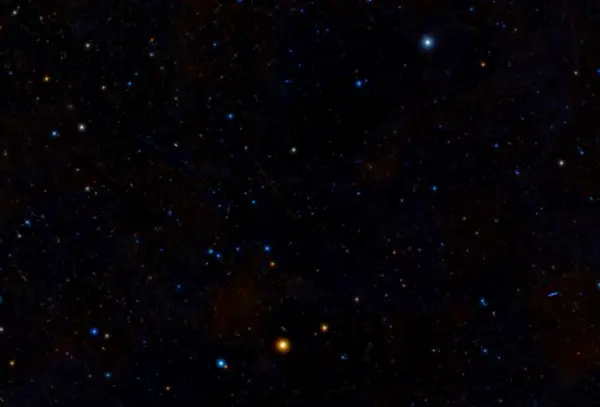
The Little Dipper, image: Wikisky
The Little Dipper lies in the far northern sky and is invisible from most locations in the southern hemisphere. Only observers in the southern equatorial latitudes can see the whole asterism. For observers in the northern hemisphere, the asterism is a permanent feature of the night sky. It is visible throughout the year, with Polaris staying in the same place and other stars appearing to rotate around it.
While the Big Dipper, the most visible part of the Great Bear constellation, is easy to see even from urban areas, the Little Dipper requires very clear, dark skies to be seen. Polaris at the tip of the Little Dipper’s handle and Kochab and Pherkad, the outer stars of the bowl, are relatively easy to spot. However, the middle four stars – Yildun, Epsilon, Eta and Zeta Ursae Minoris – are fainter than magnitude 4.00 and difficult to see from areas with too much light pollution.
The pattern of stars dominates Ursa Minor and the name Little Dipper is often used for the whole constellation. However, Ursa Minor occupies a larger area than that covered by its seven bright stars.
Constellation
The Little Dipper is the brightest part of the constellation Ursa Minor, the Little Bear. The star pattern outlines the Little Bear’s flank and tail.
Ursa Minor is one of the Greek constellations, first catalogued by Ptolemy of Alexandria in his Almagest in the 2nd century CE. The Greeks knew the constellation as Ursa Phoenicia or Phoenice (Phoenician Bear). Greek sailors used it as a navigational tool.
Ursa Minor constellation was introduced by the Greek mathematician and astronomer Thales of Miletus around 600 BCE, who was inspired by its use in Phoenicia. Phoenician sailors had showed him how to use the stars of the Little Dipper to find north. Thales created the constellation from stars that previously marked the wings of Draco, the Dragon.
In classical antiquity (from the 8th century BCE to the 6th century CE), the north celestial pole was a little closer to Kochab than it was to Polaris and the entire Little Dipper was used to find true north.
Ursa Minor is one of the smaller constellations, occupying 256 square degrees of the northern sky. It is relatively inconspicuous, containing only three stars brighter than magnitude 3.00 (Polaris, Kochab, and Pherkad). The entire constellation is visible from locations between the latitudes 90° N and 10° S. The best time of year to see it is during the month of June.
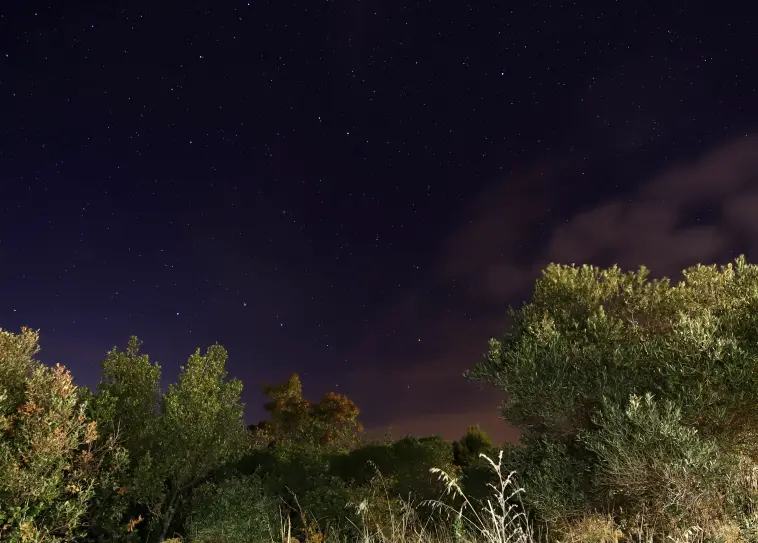
The Little Dipper and the Big Dipper, image: CG
Location
The Little Dipper always appears in the northern sky for most northern observers. Depending on the time of year, it may appear higher in the sky or closer to the horizon in the evening. Polaris always stays in the same place, while the rest of the Little Dipper appears to rotate around it.
In winter evenings (around 10 pm), the bowl appears to be dangling closer to the horizon. In spring and autumn, the handle is parallel to the horizon, and in summer, the bowl appears above the handle in the evening sky. The chart below shows the Little Dipper as it appears in early January, April, July, and October.
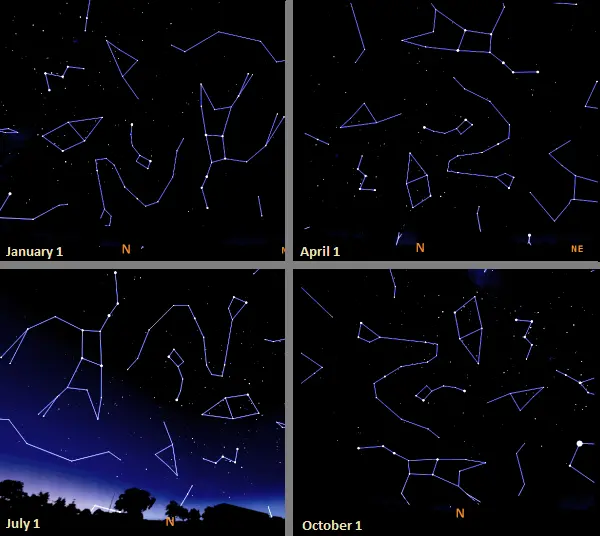
Location of the Little Dipper, image: Stellarium
How to find the Little Dipper
The Little Dipper can easily be found using the stars of the bigger and brighter Big Dipper. Kochab and Pherkad, the outer stars of the Little Dipper’s bowl, are parallel to Mizar and Alioth in the Big Dipper’s handle. Polaris at the end of the Little Dipper’s handle can be found using Merak and Dubhe, the outer stars of the Big Dipper’s bowl.
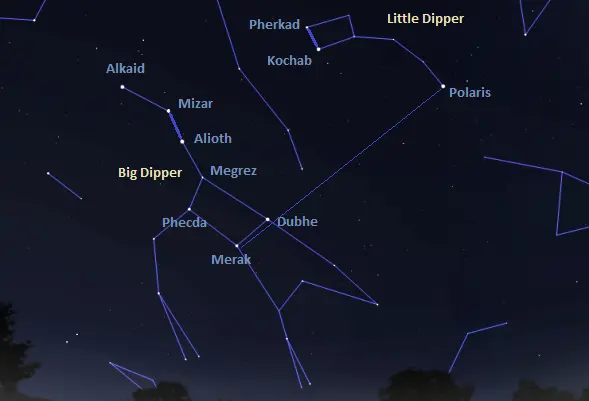
How to find the Little Dipper using the Big Dipper, image: Stellarium
How to find Polaris
Polaris can be found using the Pointer Stars in the Big Dipper. Merak and Dubhe, the outer stars of the bowl of the Big Dipper, are known as the Pointers because they point the way to the North Star. A line extended from Merak through Dubhe leads to Polaris.
Polaris does not lie exactly on this imaginary line, but it is the only relatively bright star in this area of the sky. The distance from the Big Dipper to Polaris is about five time the distance between Merak and Dubhe. Polaris is slightly fainter than Dubhe, which shines at magnitude 1.79.
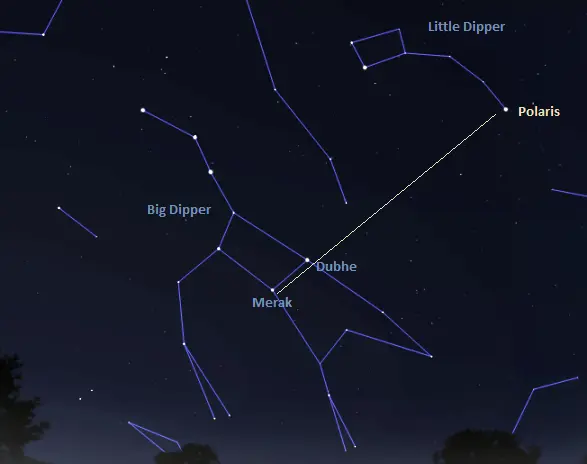
How to find Polaris using the Pointer stars in the Big Dipper, image: Stellarium
How to find the north celestial pole
Polaris marks the approximate location of the north celestial pole and is easily found by drawing a line from Merak to Dubhe in the Big Dipper. However, to pinpoint the exact location of the pole, one can use the telescopic asterism called the Diamond Ring (or Engagement Ring). The Diamond Ring is formed by a circle of 9th magnitude and brighter stars with Polaris appearing as the diamond in the ring. The ring is less than a degree across and its diameter is roughly equal to the separation between Polaris and the north celestial pole, which lies on the opposite side of the ring.
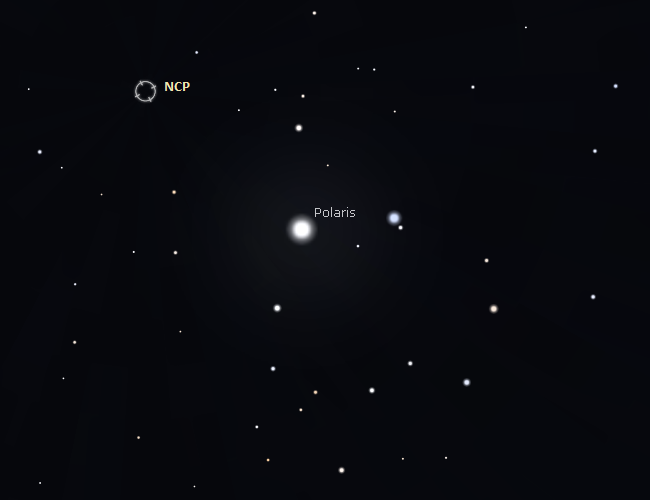
Polaris, the Diamond Ring and the north celestial pole, image: Stellarium
Constellations near the Little Dipper
The constellations bordering the Little Dipper are Draco, Camelopardalis, and Cepheus. The tail of Draco appears between the Big and Little Dippers and the rest of the constellation winds around the Little Dipper’s bowl in the direction of the Northern Cross in Cygnus.
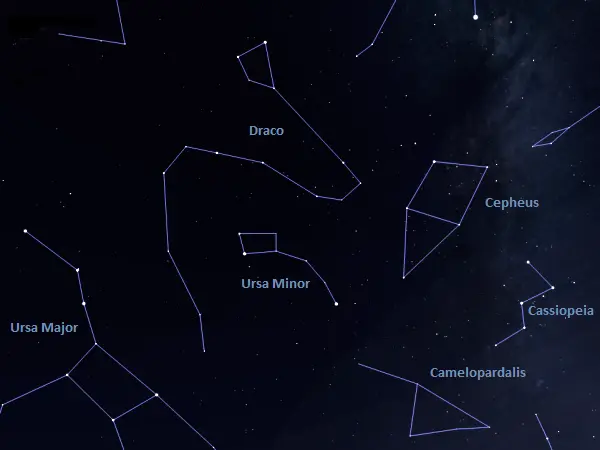
Constellations near the Little Dipper, image: Stellarium
Little Dipper stars
The Little Dipper asterism is formed by seven stars: Polaris (Alpha Ursae Minoris), Kochab (Beta Ursae Minoris), Yildun (Delta Ursae Minoris), Pherkad (Gamma Ursae Minoris), Zeta Ursae Minoris, Eta Ursae Minoris, and Epsilon Ursae Minoris.
Polaris, Yildun and Epsilon Ursae Minoris form the Little Dipper’s handle (and the Smaller Bear’s tail), while Kochab, Pherkad, Eta and Zeta Ursae Minoris form the bowl (or the Bear’s flank).
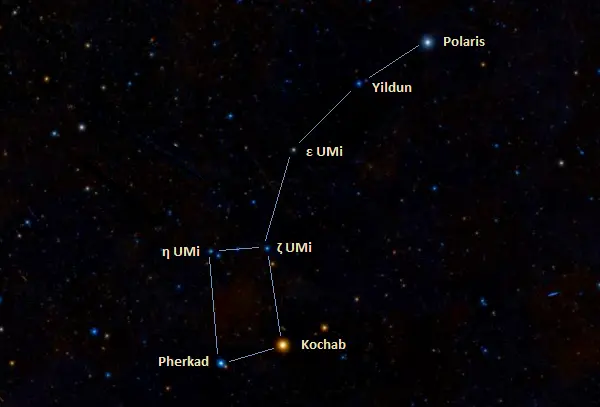
Stars of the Little Dipper, image: Wikisky
Polaris
Polaris, Alpha Ursae Minoris (α UMi), is the brightest star in Ursa Minor and the nearest visible star to the north celestial pole. Commonly known as the North Star, Pole Star or Polar Star, Polaris shines at magnitude 1.98 from a distance of about 323 – 433 light-years. As a 2nd magnitude star, it is easily visible, but not exceptionally bright. It is the 48th brightest star in the sky. Polaris is believed to be much brighter today than it was when Ptolemy observed it. In Ptolemy’s time, it was a third magnitude star.
Polaris is one of the stars in the far northern sky that serve as Pole Stars over the course of the Earth’s precession cycle. It succeeded its Little Dipper neighbour Kochab as the North Star around the year 500 CE. It will keep the role until the year 3000, when the pole shifts halfway between it and Errai (Gamma Cephei) in the constellation Cepheus.
Polaris marks the end of the handle of the Little Dipper. It is a yellow-white supergiant of the spectral type F7Ib with a mass 5.4 times that of the Sun. The star is 37.5 times larger than the Sun and 1,260 times more luminous, with a surface temperature of 6,015 K. Polaris is a young star, with an estimated age of about 70 million years.
Polaris is classified as a classical Cepheid variable. Its brightness varies from magnitude 1.86 to 2.13 over a period of about four days. Classical Cepheids are pulsating stars whose luminosity varies due to regular radial pulsations. As there is a direct relationship between their luminosity and pulsation period, these stars are used as standard candles for measuring galactic and extragalactic distances. Polaris is the nearest classical Cepheid to the Sun.
Polaris is the primary component in a triple star system. The two companions are both F-type main sequence stars. The closer companion, Polaris Ab, has a mass of 1.26 solar masses and orbits at a distance of 2.90 astronomical units. The two stars take 29.59 years to complete an orbit. They are in a wider orbit with Polaris B. Polaris B has a mass 1.39 times that of the Sun and is separated by 2,400 astronomical units from the main pair. The companions are invisible to the unaided eye. Polaris Ab has an apparent magnitude of 9.2 and Polaris B, 8.7.
The name Polaris comes from the phrase stella polaris, which is Latin for “pole star.” The name was coined in the Renaissance, when the star came within a few degrees of the north celestial pole. In the late Middle Ages, Polaris was also called Stella Maris, meaning “Star of the Sea.” An old English name, Lodestar (“guiding star”), refers to the role Polaris has played in navigation since the Middle Ages.
One of the star’s ancient names, Cynosūra, is derived from the Greek phrase meaning “the dog’s tail.” The name once applied to the constellation Ursa Minor. Polaris has been known by many other names throughout history, including Alruccabah, Navigatoria, Mismar, Phoenice, Yilduz, and the Star of Arcady.
Yildun
Yildun, Delta Ursae Minoris (δ UMi), is the middle star in the Little Dipper’s handle and in the Little Bear’s tail. It is the 7th brightest star in Ursa Minor. It shines at magnitude 4.36 from a distance of 172 light-years. The name Yildun is derived from the Turkish yıldız, meaning “star.”
Yildun is a main sequence star of the spectral type A1 Van. The nebulous absorption lines in the star’s spectrum indicated by the ‘n’ are caused by rapid spinning. The star has a projected rotational velocity of 154 km/s and completes a rotation in 19 hours.
Yildun is larger and more massive than the Sun. It has a mass 2.35 times that of the Sun and a radius 2.8 times larger. It is 47.77 times more luminous than the Sun with an effective temperature of 9,911 K.
Epsilon Ursae Minoris
Epsilon Ursae Minoris (ε UMi) is a binary star about 300 light-years away. The two stars form a single-lined spectroscopic binary system and orbit each other with a period of 39.5 days. They eclipse each other as they orbit, causing the system’s brightness to slightly decrease.
With an apparent magnitude of 4.19, Epsilon Ursae Minoris is the 4th brightest point of light in Ursa Minor, after Polaris, Kochab, and Pherkad.
The primary component in the system is a giant star of the spectral type G5 III. The star has a surface temperature of 5,215 K and spins at 25.6 km/s. The companion is a main sequence star with a spectral class in the range A8 – F0 V.
In addition to being an eclipsing binary system, one of the components is an RS Canum Venaticorum variable, a variable star whose brightness fluctuates due to large star spots.
Zeta Ursae Minoris
Zeta Ursae Minoris (ζ UMi) is the northernmost star in the Little Dipper’s bowl, the closest one to the handle. With an apparent magnitude of 4.29, it is the 6th brightest star in Ursa Minor. It lies approximately 369 light-years away.
Zeta Ursae Minoris is a main sequence star of the spectral type A3Vn. Like Yildun, it is a fast spinner, with a projected rotational velocity of 210 km/s. As a result of its fast rotation, the star has a circumstellar disk of material with an orbital radius of 42.5 astronomical units.
Zeta Ursae Minoris has a mass about 3.4 times that of the Sun and a radius 6.15 times the Sun’s. With a surface temperature of 8,720 K, it is 227 times more luminous than the Sun. The star’s estimated age is 180 million years.
Zeta Ursae Minoris was traditionally known as Ahfa al Farkadain (or Akhfa al Farkadain). The name is derived from the Arabic akhfā al-farqadayn, meaning “the dimmer of the two calves.” The star representing the other calf was Eta Ursae Minoris.
Eta Ursae Minoris
Eta Ursae Minoris (η UMi) is a main sequence star of the spectral type F5 V. It has a mass 1.35 times that of the Sun and a surface temperature of about 6,858 K. It is the 10th brightest star in Ursa Minor, shining at magnitude 4.95 from a distance of 97 light-years.
Eta Ursae Minoris may have a companion, a magnitude 15.3 star at a separation of 228.5 arcseconds. Like its Little Dipper neighbours, it is a fast rotator, spinning at 84.8 km/s. The star’s estimated age is 1.061 billion years.
Eta Ursae Minoris has the traditional name Anwar al Farkadain, derived from the phrase anwar al-farqadayn, meaning “the brighter of the two calves.”
Eta, Zeta, and Epsilon Ursae Minoris do not have formal names. Their traditional names have not been officially approved by the International Astronomical Union (IAU).
Kochab
Kochab, Beta Ursae Minoris (β UMi), is the second brightest star in Ursa Minor. It is the brighter of the two outer stars of the Little Dipper’s bowl. Shining at magnitude 2.08, Kochab is only slightly fainter than Polaris. It is the 57th brightest star in the sky. It lies 130.9 light-years away.
Kochab is an evolved red giant star of the spectral type K4 III. It has a mass of 2.2 solar masses and a radius 42.06 times that of the Sun. With an effective temperature of 4,030 K, it shines with 390 solar luminosities. The star is a relatively slow spinner, with a projected rotational velocity of 8 km/s.
Kochab hosts a planet around 6.1 times as massive as Jupiter. The planet orbits the star with a period of 522 days. Its discovery was reported in 2014.
The origin of the name Kochab is uncertain. It may be derived from Rucaba or Alrucaba, a name that was used for the star closest to the north celestial pole. The name may also come from the Arabic al-kawkab or Hebrew kōkhāv. Both these terms denote a celestial body (a star or a planet).
Kochab and its neighbour Pherkad are known as the Guardians of the Pole because they always circle Polaris. They served as twin pole stars from 1500 BCE to 500 CE, before the Earth’s axis aligned more closely with Polaris. Neither star was as close to the celestial pole as Polaris is today.
Pherkad
Pherkad, Gamma Ursae Minoris (γ UMi), is a giant star of the spectral type A2 III. With an apparent magnitude of 3.05, it is the third brightest star in Ursa Minor. It lies about 487 light-years away.
Pherkad is 15 times larger than the Sun and 1,100 times more luminous, with a surface temperature of 8,280 K. It is a fast spinner, with a projected rotational velocity of 180 km/s. As a result, it has a circumstellar disk of ejected material and is classified as a shell star.
The name Pherkad is derived from the Arabic farqad, meaning “calf.” It comes from the phrase aḫfa al farkadayn, “the dim one of the two calves.” (The name Ahfa al Farkadain was traditionally used for Zeta Ursae Minoris.)
Gamma Ursae Minoris is sometimes referred to as Pherkad Major to distinguish it from its visual companion, 11 Ursae Minoris (Pherkad Minor). The two stars appear close in the sky, but are not physically related. 11 Ursae Minoris is a single orange giant star located approximately 410 light-years away. It hosts a planet, discovered in August 2009.
Facts
Polaris was not always the North Star, nor will it stay the northernmost star forever. It is one of the far northern stars that take turns as the Pole Star over the course of Earth’s 26,000-year precession cycle. Polaris is the third brightest of the North Stars (after Vega in the constellation Lyra and Deneb in Cygnus), and the second most accurate marker of true north, after Thuban in Draco. Thuban comes within 0.2° of the pole and Polaris within 0.5°.
The Latin word for “north,” septentrio, is a reference to the seven bright stars of the Little Dipper that point the way north. The word is derived from septem triones, meaning “seven oxen.”
Mythology
In Greek mythology, the constellations Ursa Major and Ursa Minor are associated with the myth of Arcas and his mother Callisto. Callisto was a nymph who had a son by Zeus and was transformed into a bear by the jealous Hera. Callisto’s son, Arcas, grew up to be a great hunter and became king of Arcadia. During one of his hunts, he came across the bear and, not knowing that it was his mother, he aimed an arrow at it. Zeus prevented a tragedy by placing the mother and son into the sky as the constellations Ursa Major and Ursa Minor. Callisto is associated with Ursa Major and Arcas with Ursa Minor.
In the early myths, the seven stars that form the Little Dipper represented the Hesperides, the nymphs who were tasked with guarding Hera’s orchard where immortality-giving apples grew. The nymphs occasionally plucked from the grove and Hera placed Ladon, a never-sleeping dragon with a hundred heads, to keep an eye on them. Ladon is represented by the neighbouring constellation Draco. Heracles defeated the dragon and stole the golden apples as part of his eleventh labour.
In a different myth, the two bear constellations are linked with Adrasteia and Ida, the Cretan nymphs who looked after Zeus when he was little. Zeus’ mother Rhea hid the infant Zeus on the island of Crete to protect him from his father Cronus. Cronus had received a prophecy that one of his children would overthrow him and he swallowed five of his older children after they were born. Zeus eventually fulfilled the prophecy and freed his siblings.
Ursa Minor constellation was also known as Cynosura, meaning “dog’s tail” in Greek, but the origin of the name is uncertain.